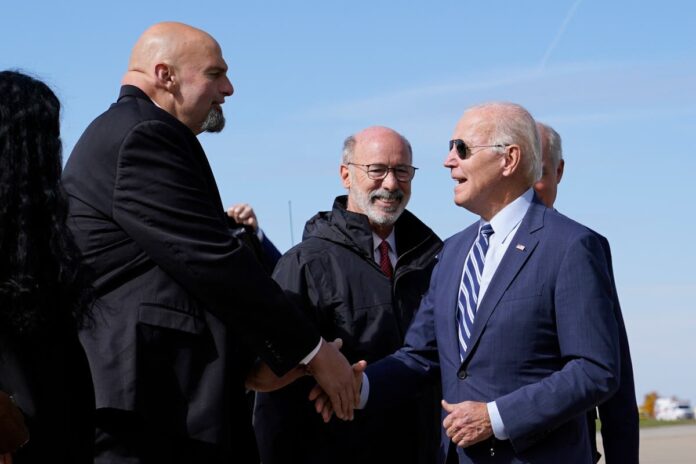Just a couple of months ago, it looked like Democrats might achieve an almost impossible feat in modern electoral politics. The end of Roe v Wade and ongoing attacks on abortion rights had galvanised voters, giving the party hope of keeping their majority in Congress, even while the incumbent Democratic president’s approval ratings were deep underwater.In the last few weeks, however, their gravity-defying act looks to have ended. An average of polls show Republicans with the momentum heading into the final stretch. Since August, the GOP has led on the generic ballot – that is, national polling on which party voters will support in the Midterms. Voter enthusiasm, a key indicator of strength, has also trended higher for Republicans.Those polls may not tell the whole story, however. With voting already underway across the country, early ballot returns may offer a glimmer of hope for Democrats, according to Michael McDonald, an election expert and associate professor of political science at the University of Florida who monitors early voting data.’If there’s one tea leaf to read, besides overall turnout, it is potentially about the direction or how close some of these interesting Senate elections may be,’ he told The Independent this week, while cautioning that it was still very early in the process and things could change.Mail ballot return rates are the percentage of people who requested a ballot and returned it, which may give some clues about voter enthusiasm.According to the early voting data, while mail ballot return rates nationally have slightly favoured Republicans, Democrats have the edge in return rates in those key Senate races that will decide control of the chamber.’I’m looking at the mail ballot return rates nationally, and registered Democrats are returning their ballot at a slightly lower rate than what you’re seeing for registered Republicans,’ he said. ‘But if you look at some of these competitive senate races where we have party registration data, places like Pennsylvania and North Carolina and Arizona, you see a different story – you actually see a greater share of registered Democrats returning their mail ballots than Republicans.’That means that national polling largely matches up with early voting data in showing a generic Republican lead, but Democratic enthusiasm may be most prevalent where it matters, in those deciding states.’It explains why nationally, if you view a generic ballot, there had been this story for the last week that Democrats are suddenly in trouble because their enthusiasm is waning and Republicans are picking up. But the national news is one thing, and when the national polls are including states like California, where there’s no real marquee election or gubernatorial or US senate election to draw people to the polls, it’s not surprising. There’s not as much enthusiasm there as you might find in, say, Pennsylvania or North Carolina or Georgia.’Polling has been notoriously difficult and error-strewn in recent years, but early voting data can offer the first concrete signpost of voter behaviour. In 2020, early voting numbers foretold a record-breaking turnout. Professor McDonald wrote this week that in Pennsylvania, one of the most closely watched and important races in the country for deciding control of the senate, registered Democrats have returned 39.9 per cent of their requested mail ballots compared to 37.9 per cent of Republicans.’Pennsylvania Democrats also have a lopsided advantage in mail ballot requests, so the sum of the request and return advantage translates into nearly a four-fold advantage for Democrats among returned mail ballots,’ he wrote. Similar trends are visible in Arizona and North Carolina, he added, where Democratic return rates outnumber Republicans by 10.3 per cent to 9.0 per cent, and 28.2 per cent to 27.3 per cent.The early data also suggests that this year’s midterms may break records for the number of votes cast, overcoming 2018’s previous record, which was the highest turnout since 1914. Nearly 15 million people have already voted, with two weeks to go.Professor McDonald said those numbers reflect a growing tendency towards polarisation in American politics.’It just makes sense that we’ve entered this period of time in our politics where we’re highly polarized and people believe that their vote matters. And when people believe or their vote matters, they’re more likely to cast a ballot,’ he said.Both parties have cast this year’s midterms as crucial to the fate of the country.Dozens of Republican candidates running for office across the country have embraced conspiracy theories about the 2020 election, including several running for positions that oversee the administration of elections. If they are successful, they may be able to overturn the results of a free and fair election in 2024, handing victory to their preferred candidate.At the beginning of the midterm campaign, president Joe Biden cast the vote as a battle for democracy.’Donald Trump and the MAGA Republicans represent an extremism that threatens the very foundations of our republic,’ Mr Biden in a September speech in front of Independence Hall in Philadelphia. ‘They’re working right now as I speak in state after state to give power to decide elections in America to partisans and cronies, empowering election deniers to undermine democracy itself.’Republicans, meanwhile, have put a renewed focus on crime and inflation, two issues on which they have used to realise big gains in recent weeks.Mr Biden’s low favourability rating, which is currently around 42 per cent, has been a major concern for Democratic candidates heading into the midterms. Traditionally, voters use midterm elections to punish unpopular presidents, which can hamper their ability to pass laws in the second half of their term.
Early voting numbers offer a glimmer of hope for Democrats in midterms
Sourceindependent.co.uk
RELATED ARTICLES


